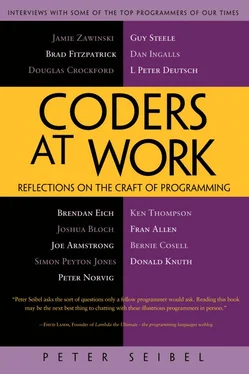Peter Seibel - Coders at Work - Reflections on the craft of programming
Здесь есть возможность читать онлайн «Peter Seibel - Coders at Work - Reflections on the craft of programming» весь текст электронной книги совершенно бесплатно (целиком полную версию без сокращений). В некоторых случаях можно слушать аудио, скачать через торрент в формате fb2 и присутствует краткое содержание. Жанр: Программирование, на английском языке. Описание произведения, (предисловие) а так же отзывы посетителей доступны на портале библиотеки ЛибКат.
- Название:Coders at Work: Reflections on the craft of programming
- Автор:
- Жанр:
- Год:неизвестен
- ISBN:нет данных
- Рейтинг книги:3 / 5. Голосов: 1
-
Избранное:Добавить в избранное
- Отзывы:
-
Ваша оценка:
- 60
- 1
- 2
- 3
- 4
- 5
Coders at Work: Reflections on the craft of programming: краткое содержание, описание и аннотация
Предлагаем к чтению аннотацию, описание, краткое содержание или предисловие (зависит от того, что написал сам автор книги «Coders at Work: Reflections on the craft of programming»). Если вы не нашли необходимую информацию о книге — напишите в комментариях, мы постараемся отыскать её.
Coders at Work
Founders at Work
Coders at Work: Reflections on the craft of programming — читать онлайн бесплатно полную книгу (весь текст) целиком
Ниже представлен текст книги, разбитый по страницам. Система сохранения места последней прочитанной страницы, позволяет с удобством читать онлайн бесплатно книгу «Coders at Work: Reflections on the craft of programming», без необходимости каждый раз заново искать на чём Вы остановились. Поставьте закладку, и сможете в любой момент перейти на страницу, на которой закончили чтение.
Интервал:
Закладка:
Seibel:Are there situations today where you think turning off the computer and clearing your desk is the right approach?
Steele:Yeah, I still do that. In fact, I find that I literally have to turn off the computer because if the fan is whirring behind me there’s the lure of “Check your email, check your email.” So I’ll turn it off or at least put it to sleep, come over to this table on the other side of the room, and spread out my papers and think. Or work at the whiteboard or something.
Seibel:I read something where you paraphrased Fred Brooks’s saying about flowcharts and tables, saying, “Show me your interfaces and I won’t need your code because it’ll be redundant or irrelevant.” When you’re working in a language like Java, do you start your designs from interfaces?
Steele:Yeah, I’ve become much more interface-oriented than I used to be. Descriptions of the inputs and actions and outputs of methods with no code. I love writing that stuff. I also enjoy writing the code that implements it, but I do less of that nowadays than I used to. And of course it’s important to have had an experience doing that so you don’t design impossible specifications. You should have an idea what the implementation is going to look like as you design the interface. You should at least have an idea for the implementation. Then if someone comes along with a better one, that’s fine.
Seibel:Other than the possibility of implementing it at all, how do you decide whether your interfaces are good?
Steele:I usually think about generality and orthogonality. Conformance to accepted ways of doing things. For example, you don’t put the divisor before the dividend unless there’s a really good reason for doing so because in mathematics we’re used to doing it the other way around. So you think about conventional ways of doing things.
I’ve done enough designs that I think about ways I’ve done it before and whether they were good or bad. I’m also designing relative to some related thing that I’ve already designed before. So, for example, while looking at the specifications for numeric functions in Java, I’d already done numeric functions for Common Lisp. And I’d documented numeric functions for C. I knew some of the implementation pitfalls and some of the specification pitfalls for those things. I spent a lot of time worrying about edge cases.
That’s something I learned from Trenchard More and his array theory for APL. His contention was that if you took care of the edge cases then the stuff in the middle usually took care of itself. Well, he didn’t say it that way; I guess that’s the conclusion I draw from him.
To turn it around, you want to design the specification of what’s in the middle in such a way that it naturally is also correct on the boundaries, rather than treating boundaries as special cases.
Seibel:During your time at MIT you were somehow involved in the birth of Emacs. But the early history of Emacs is a bit hazy. What is your version of the story?
Steele:My version of the story was that I was playing standards guy. What had happened was there was this display mode that turned TECO into something like a WYSIWYG editor. On our 24x80 screens, 21 lines of what was in the buffer would be shown on the screen and the bottom 3 lines were still a TECO command line. You’d be typing in these TECO commands and only when you hit the double almode would they then be executed. Then there was the real-time edit mode, where it was suggested that a TECO command throw you in this other mode whereby instead of waiting for you to type the double altmode, TECO would react immediately to single character commands. If you type one character, it would do the command. You type another character, it would do the command. And most printing characters were self-inserting. Then the control characters were used to move forward, back, up, and down. It was a very, very primitive—it looked like a very primitive version of Emacs.
Then came the breakthrough. The suggestion was, we have this idea of taking a character and looking it up in a table and executing TECO commands. Why don’t we apply that to real-time edit mode? So that every character you can type is used as a lookup character in this table. And the default table says, printing characters are self-inserting and control characters do these things. But let’s just make it programmable and see what happens. And what immediately happened was four or five different bright people around MIT had their own ideas about what to do with that. Within just a few months there were five completely incompatible GUI interfaces to TECO.
Seibel:So they were just customizing, essentially, the key-bindings?
Steele:That’s right. And they each had their own ideas about what should be concise because you do it most often and what you can afford to be longer. So one guy, for example, was really concerned about typing in Lisp code and began to experiment with finding balanced parenthesized expressions. And another guy was more interested in text, so he was interested in commands that would move over words and convert between uppercase and lowercase and capitalize them. And that’s where those commands in Emacs came from.
Different people had different ideas about how the key-bindings ought to be organized. As a systems-support guy for Lisp, I was often called to people’s terminals and asked to help them. And I fairly quickly noticed that I couldn’t sit down at their TECOs and help them modify their programs because I’d be faced with a set of key-bindings and I had no idea what they were going to do.
Seibel:Was one of these guys Richard Stallman?
Steele:No, Stallman was the implementer and supporter of TECO. And he provided the built-in real-time edit mode feature, although I think Carl Mikkelsen had worked on the early version of it. He provided the keybindings feature that made all of this possible.
Anyway, there were something like four different macro packages and they were incompatible, and I decided to play standards guy, or community reconciliation guy. I saw something that had been lost in our community, which was the ability to easily help each other at our terminals. I said, “OK, we’ve had some experimentation; we’ve seen a bunch of ideas. What if we could agree on a common set of key-bindings and draw the best ideas from each of these things?”
I literally had a pad of paper and ran around the building, talking to these guys, visiting each of them several times, and tried to get some kind of consensus. I was trying to get consensus on what the content ought to be and then I drew on their designs and tried to organize the actual choice of key-bindings so as to make them a little more regular and a little more mnemonic. And not being a human-factors guy at all, I didn’t think at all about convenience for touch typists. I was principally concerned with mnemonic value. And so that’s why Meta-C and Meta-L and Meta-U stand for capitalize and lowercase and uppercase.
Seibel:Which is sort of ironic given the way the commands move out of your brain and into your fingers. I’m sure you have experienced the phenomenon of having someone ask you what is the key-binding for something that you use a thousand times a day, and you can’t say.
Steele:Actually my wife had that experience. Maybe one of the reasons I was less aware of it is that I’m not a particularly good touch typist. But she’d been away from Emacs for 20 years and then I made one available on her Macintosh. And she sat down, typed in some stuff, and then said, “How do I save this? I forget how to save a file.” And then she realized her fingers had done it and she didn’t know what she’d typed. So she did it again and watched her fingers and said, “Oh yes, Control-X Control-S.” But she literally couldn’t remember what the commands were.
Читать дальшеИнтервал:
Закладка:
Похожие книги на «Coders at Work: Reflections on the craft of programming»
Представляем Вашему вниманию похожие книги на «Coders at Work: Reflections on the craft of programming» списком для выбора. Мы отобрали схожую по названию и смыслу литературу в надежде предоставить читателям больше вариантов отыскать новые, интересные, ещё непрочитанные произведения.
Обсуждение, отзывы о книге «Coders at Work: Reflections on the craft of programming» и просто собственные мнения читателей. Оставьте ваши комментарии, напишите, что Вы думаете о произведении, его смысле или главных героях. Укажите что конкретно понравилось, а что нет, и почему Вы так считаете.












